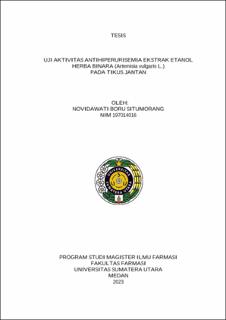Uji Aktivitas Antihiperurisemia Ekstrak Etanol Herba Binara (Artemisia vulgaris L.) pada Tikus Jantan

Date
2023Author
Situmorang, Novidawati Boru
Advisor(s)
Harahap, Urip
Hasibuan, Poppy Anjelisa Zaitun
Metadata
Show full item recordAbstract
Hyperuricemia is a metabolic disorder characterized by high levels of uric acid in the body. If the concentration of uric acid is excessive, it has the potential to form uric acid crystals in the kidneys. In addition, high uric acid levels can also damage the kidneys by increasing Reactive Oxygen Species (ROS). The activity of reducing uric acid levels is thought to be due to flavonoid compounds acting as antioxidants as well as quercetin with the potential through xanthine oxidase inhibitors. This study aims to assess and analyze the effect of herb binara extract (Artemisia vulgaris L.) on decreasing uric acid levels, decreasing serum urea, decreasing serum creatinine, and improving kidney in hyperuricemia rats induced by potassium oxonate.
This study used 32 rats which were divided into 8 groups. The EEHB dose used in this study was 50; 100; 200; 400 and 800 mg/kg bw, allopurinol was used as a positive control and CMC-Na as a negative control, the normal group was used in this study. Hyperuricemia rats were given daily herb extracts. Uric acid levels and urine volume were measured on days 0, 3, 7, 14 and 28, while serum creatinine, urea and histopathological levels were measured on day 28.
The results of the analysis showed that administration of EEHB doses of 800, 400, 200, 100 and 50 mg/kg bw could significantly reduce levels of uric acid, serum creatinine, and serum urea compared to the negative control group in rats induced by potassium oxonate. Administration of EEHB doses of 800, 400, 200, 100 and 50 mg/kg bw was able to improve the histopathological picture of the hyperuricemia rat kidney induced by potassium oxonate.
Collections
- Magister Theses [371]
